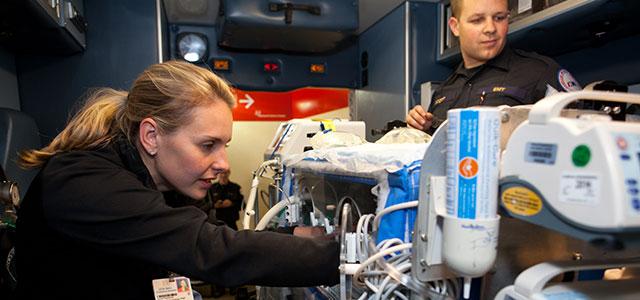
Nurse practitioner Elizabeth Colglazier leads a transport team for UCSF Benioff Children's Hospital (photo by Elisabeth Fall).
NPs Fill “Critical” Gaps in Health Care Delivery
Many experts believe the next and perhaps most important phase of health care reform will be what is known as delivery system reform: creating or revamping existing systems to wrest the highest quality and most efficient care from all of health care’s diverse resources.
In this context, the role of advanced practice nurses is receiving considerable attention. While much of the attention – and some controversy – has focused on nurse practitioners (NPs) in the primary care setting, in acute care the NP role has been growing steadily, with NPs assuming and devising essential roles that clearly advance the goals of delivery system reform.
It’s a process with which members of the Pediatric Intensive Care Unit (PICU) at UCSF Benioff Children’s Hospital are quite familiar.
It began a few years ago, when clinicians there began thinking about having acute care pediatric nurse practitioners (ACPNPs) lead the transport teams that bring acute or critically ill children from referring hospitals to the children’s hospital PICU.
Historically, a critical care fellow had led these teams; more recently, a group of on-call, newly graduated pediatricians assumed the role. “But given all the rotating through, it was difficult to have a consistent physician leader, much less a pediatric critical care-trained physician,” says pediatric critical care physician Arup Roy-Burman, who became medical director of the PICU in 2011.
The theory was that putting NPs in charge would create more consistent leadership for the transport teams and, by being cross-trained in both transport and the PICU, the NPs would be able to immediately initiate the PICU’s critical care patient management strategies. It was a sensible, patient-centered concept for the era of health care reform, but working out the details would take time.
PNP Robyn Huey made the time.
Defining the Role
A veteran bedside nurse in the children’s hospital PICU and graduate of the UC San Francisco School of Nursing Acute Care Pediatric Nurse Practitioner (ACPNP) program (see sidebar), in 2011 Huey was completing her Doctor of Nursing Practice from the University of San Francisco. She and her colleague Elizabeth Colglazier – another veteran PICU nurse and graduate of the UCSF ACPNP program – believed that NPs should play an important clinical role in the PICU, beyond just transport. So for her dissertation, Huey gave herself the task of defining the new role.
 Robyn Huey She met with PICU staff, including nurse managers, nurses, attending physicians, residents and fellows. She interviewed dozens of clinicians across the country, in settings where NPs had been integrated into PICUs for years. After detailing the vision and initially defining the roles, she presented her findings to the PICU leadership team, and they agreed to pilot a program in which reimbursement from the transport service would fund NPs’ time in the PICU. Later, Mary Lynch, who directs the ACPNP program at UCSF School of Nursing, was called in to help with the transition and consult on further defining the PICU roles.
Robyn Huey She met with PICU staff, including nurse managers, nurses, attending physicians, residents and fellows. She interviewed dozens of clinicians across the country, in settings where NPs had been integrated into PICUs for years. After detailing the vision and initially defining the roles, she presented her findings to the PICU leadership team, and they agreed to pilot a program in which reimbursement from the transport service would fund NPs’ time in the PICU. Later, Mary Lynch, who directs the ACPNP program at UCSF School of Nursing, was called in to help with the transition and consult on further defining the PICU roles.
“We hoped eventually to get more funding and have dedicated NPs for both transport and the PICU, but that’s not going to be feasible for a while,” says Huey, referring to today’s difficult economic climate. While optimizing their impact in the PICU demands that NPs be consistently present – something made impossible by the unpredictable demands of the transport service – Huey, Colglazier, the other three NPs (Claire Parker, Meredith Lahey and Jennifer Delozier Smith) and their physician colleagues understand the necessity of the compromise.
“In and of itself, transport really has nothing to do with the NP role in the PICU,” says pediatric critical care physician Peter Oishi, who oversees the NP program at the children’s hospital. “But having the NPs cross-trained in a critical care transport role does make a ton of sense. With time and experience, they will become comfortable with critically ill kids in a way that rotating residents or even recently graduated pediatricians can’t possibly be.”
The Transport Role
Huey and Colglazier say that despite the unpredictability, the transport role can be very satisfying because of the autonomy the NPs enjoy. “We’ll call back to the PICU to discuss the care plan, but then it’s ultimately up to us to decide on how to care for each patient,” says Colglazier. “It’s also helpful that the nurses we work with have a great deal of transport experience.”
It’s also helpful that the NPs have built trust with the fellows and attendings. “Sometimes I can’t tell you what the diagnosis is, but I know a patient doesn’t look good and the PICU physicians trust my assessment,” continues Colglazier. “I’m their eyes, the one giving them a realistic image of what the patient looks like.… When a patient is decompensating, I let them know, and if I can’t contact them, I feel qualified to make the right clinical decision.”
In the PICU
Back in the PICU, Oishi believes the NPs fill multiple needs. Two are particularly important in his vision for how the role will evolve.
 In the PICU, from left: Mary Lynch, Peter Oishi, Elizabeth Colglazier, Alissa Smalling, Arup Roy-Burman “As they gain experience, I see the NPs as equivalent to our fellows,” he says. “They would help a single attending and/or fellow cover more ground, even as they orient and supervise residents.”
In the PICU, from left: Mary Lynch, Peter Oishi, Elizabeth Colglazier, Alissa Smalling, Arup Roy-Burman “As they gain experience, I see the NPs as equivalent to our fellows,” he says. “They would help a single attending and/or fellow cover more ground, even as they orient and supervise residents.”
In many ways, says Huey, the NPs are already playing that role. She offers the example of a critically ill infant having just emerged from major cardiac surgery; in such a case, it is very difficult for the fellow or attending to leave that patient’s side in the cardiac ICU. Yet one floor down in the medical/surgical PICU, there’s another child who has just had a brain tumor resected, who also needs constant evaluation by somebody with critical care experience.
“And there are 16 other patients, who may need their orders revised – and this is where the NPs follow up on day-to-day care,” says Huey. “We also work with specialty services, who see us as a facilitator when they can’t get ahold of the fellow or attending.”
Oishi says the second unique and essential role is providing vascular access expertise, especially since the NPs already do a lot of arterial line and PICC (peripherally inserted central catheter) placements.
“Moving ahead, the NPs can and should be the vascular access experts that the attendings are – and that’s crucial because vascular access is so much harder in kids than in the adult world,” says Oishi. “Kids’ veins are small, their parents are worried; it’s a big deal and it takes practice, but once you have the skill, you can provide an invaluable service to the rest of the hospital.”
Continuity of Care, Translation Between Professions, and Quality Improvement
Another key role is providing continuity of care, particularly for the many patients who have extended stays in the PICU. The NPs’ steady presence gives them nuanced insights into these patients’ clinical needs, as well as a clear understanding of how to work with the patients and their families – a particular strength of nursing and NP training. The NPs can then pass this information on to the residents, along with advice on the day-to-day workings of the unit and guidance on critical care clinical skills.
“We wind up doing a lot of resident education,” says Colglazier. “We’d also like to be more involved in nursing education.” In fact, the NPs’ ability to smoothly traverse the worlds of medicine and nursing also puts them in a unique position as translators between the two professions.
“They give physicians a better understanding of the practical issues when we’re laying out a care plan,” says Roy-Burman. “And they do a great job of helping nurses understand what the physicians are trying to do and creating protocols for how to get it done.”
Finally, due to their training, NPs are well suited to envisioning and helping implement procedural changes that improve the quality of care.
“They’ve done great work in these areas,” says Roy-Burman, citing efforts to reduce line infections, improve the efficiency of rapid response teams and create a gamification project aimed at motivating ongoing improvements. “My goal is to match their interests with an activity so they can continue to grow professionally.”
Training Challenges
Despite the NPs’ obvious value, a few key challenges remain.
One of the most prominent is balancing the training needs of the residents with clinical priorities and the training needs of the NPs.
“We have good relationships with the residents, but some of them do feel that our presence takes away from their experience,” says Huey. “Some worry that we’re managing all their patients, so we try to ease this by pulling them in more when we’re doing things like writing orders.”
“It is a challenge,” says Roy-Burman about creating a balance. “Keep in mind that we are an academic medical program that trains both residents and fellows and it’s important to maintain the integrity of that.”
Oishi uses airway skills as an example of why this can be so tough. When a patient in the PICU needs to be intubated, the senior fellow has to decide if a resident or the NP gets to do it.
“I remember how much I wanted to do those things as a resident,” says Oishi. “But the reality is a pediatric resident who goes on to general pediatrics or a specialty outside of intensive care will probably never need to put in a central line or intubate someone.… And if I’m sending an NP out to get a kid, she better have some airway skills. For me, [the issue of who should have the priority for training on these specific types of procedures] is a settled question from a patient’s standpoint and from the institution’s risk management standpoint.”
He expects some of the tension may ease as physician-training requirements change and resident hours become even more restricted. In addition, he and Roy-Burman believe regular meetings with the NPs and residents are helping them to work through some of these issues.
“It’s already getting better,” says Colglazier. “Especially as the residents rotate through the PICU for the second time, they remember us and are much more open to our role.”
The NP Mindset
Roy-Burman and Oishi – both strong supporters of the NP role – do worry, however, that the struggles some NPs have with the transition from bedside nurse to NP could restrict their ability to grow the role.
“It’s about moving from the shift mentality to more of a professional, salaried model,” says Oishi.
 Colglazier notes that part of the problem is that unlike their physician colleagues, the NPs are paid hourly and through the Department of Nursing at UCSF Medical Center. “We are still working on how to balance the expectations from both our nurse managers and physician colleagues,” she says.
Colglazier notes that part of the problem is that unlike their physician colleagues, the NPs are paid hourly and through the Department of Nursing at UCSF Medical Center. “We are still working on how to balance the expectations from both our nurse managers and physician colleagues,” she says.
“But when you become an advanced practice nurse, you have to give up the idea you’re going to get paid for all the time you work,” says Sandra Staveski, who teaches in the ACPNP program at UCSF School of Nursing and works half-time as an NP at the Lucile Packard Children’s Hospital cardiovascular ICU, where she helped forge the role. “You just have to think, ‘I get paid a very nice wage for work that I want to be doing.’”
Part of easing the transition, says Colglazier, has to do with a mental approach to the work and NP training. “Most NP education programs involve projects other than clinical work; in the PICU these extra projects really allow the physicians to see that the NP can have an expanded role,” she says.
Oishi and Roy-Burman agree.
“Ultimately, if we had a group of seasoned NPs, who felt like true colleagues, there’d be enormous job satisfaction, and they’d be an incredible resource,” says Oishi. “That’s where we’d like to get it.”
Making the Economics Work Is Key to Future
That vision is partly driven by increasing appreciation of the unique skill set that NPs bring to the PICU.
“It’s a blend of understanding nursing while also having a medical background,” says Shannon Fitzpatrick, who manages the children’s hospital PICU and is also a graduate of the ACPNP program at UCSF School of Nursing. “Even in those most acute moments, when a child is very critical, there needs to be awareness of the medical team’s priorities and the family’s and patient’s. Our doctors have a wonderful bedside manner, but NPs’ psychosocial background helps the team navigate the balance.… They really have one of the broadest roles in this unit, and their presence has improved patient care here, no doubt.”
“We help create a different model for caring for sick children,” says Staveski. “For us it’s not only about curing illness and disease, but also about how you create a healing environment to get these children to optimal states of health.”
The hope, therefore, is that somehow the team can make it economically feasible to create separate roles that optimize those skills, with some NPs dedicated to transport and others dedicated to the PICU. Nurses could still be cross-trained and do shifts with either team, but the shifts themselves would be dedicated shifts that would allow the NPs to realize their full potential in the PICU.
“We all – including the institution funding the program – want to grow transport; the PICU faculty would really like to develop the PICU part of the program as well,” says Roy-Burman. “If we can do both and continue to show value, maybe we can support those who want to dedicate their time to the PICU.”
Huey hopes so, given the progress that has been made. “It’s taken a lot of meetings, a lot of conversations, but I think [the attendings Roy-Burman and Oishi] are disappointed now when an NP is not in the PICU working with them,” she says.



